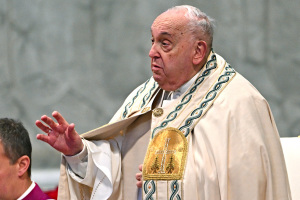Christian nationalism: The ‘right-wing’ overcorrection we’ve seen before?

Christian nationalists — as I’ve written about before [here, here, and here] — deserve credit where credit is due. Their critiques of the radical left are often correct. They rightly oppose abortion, LGBTQ ideology, big pharma, abuse in foreign relations and spending, and unchecked mass migration. Their emphasis on a ‘moral and religious’ society is on-point (at least in word). Their outrage at the widespread corruption of the Biden administration (among decades of outright federal betrayal) is well-founded. They’re also largely justified in calling out the rot within Evangelical circles — particularly the compromised leadership of “Big Eva,” where progressive theology and politics have infiltrated the Church. Their rejection of WEF-style globalism is prudent, as well.
But they risk swinging the pendulum too far — replacing one form of tyranny with another and building a system that threatens individual liberty and freedom of conscience — the very foundation of the American experiment — under the guise of societal stability, structure, safety, power, and 'holy' tradition.
To grasp this tendency toward over-correction, we need to zoom out and examine the broader historical patterns.
We've seen this movie before...
Fascism, for example, as a political force, didn’t emerge in a vacuum — it was a visceral “right-wing” reaction to a world spiraling into chaos after World War I. The war left Europe shattered: economies in ruins, millions dead, and empires like Austria-Hungary and Ottoman Turkey dissolved into fractious states. Amid this wreckage, the 1917 Bolshevik Revolution in Russia ignited a Marxist firestorm that terrified the old order. The execution of Tsar Nicholas II and his family wasn’t just regicide — it was a symbolic annihilation of tradition, religion, and hierarchy. Lenin’s regime promised a classless utopia, but its immediate export was violence, upheaval, and authoritarian control. By 1919, communist uprisings had erupted in Hungary (the short-lived Hungarian Soviet Republic), Germany (the Spartacist uprising), and beyond, each threatening to topple fragile governments and replace them with Soviet-style rule. This, naturally, led to the brute backlash we call fascism.
In Italy, the Biennio Rosso (“Two Red Years,” 1919–1920) saw socialist strikes, factory occupations, and street clashes that paralyzed the nation. The liberal government floundered, unable to restore order. Into this breach stepped Benito Mussolini, a former socialist turned nationalist. His Blackshirts — paramilitary squads — crushed leftist agitators, promising a return to “Roman glory.” Mussolini famously declared in 1922, as he marched on Rome: “We have buried the putrid corpse of liberty!” For many Italians at that time, weary of further leftist instability, this wasn’t tyranny — it was salvation, safety (over freedom), and relief (sound familiar?). By 1925, he’d consolidated power, banning opposition and exalting the state above all (sounds just like the communism he was opposing, if you ask me).
Germany’s story, as many of us know, was bleaker still. The Weimar Republic, born in 1919, was a punching bag for both communists and nationalists. The Treaty of Versailles had gutted the nation — hyperinflation in 1923 saw wheelbarrows of Reichsmarks traded for bread, while the Communist Party of Germany (KPD) staged revolts like the 1923 Hamburg Uprising. Adolf Hitler, an obscure agitator in Munich’s beer halls, seized on this despair. He, like other authoritarian strongmen, did not waste a good crisis. In Mein Kampf (1925), he railed against “Judeo-Bolshevism,” blaming Marxists and Jews for Germany’s humiliation (again, sound familiar?). To give the devil some credit (bear with me), he wasn't entirely wrong about the abuses of Marxism within German society, but every good lie has a fair bit of truth.
“Discernment is not the ability to tell the difference between right and wrong; rather, it is telling the difference between right and almost right” (Charles Spurgeon).
His Nazi Party gained traction not as a lunatic fringe but as a ‘lone bulwark’ against the red tide of Karl Marx and Friedrich Engels' Communist Manifesto applied. By 1933, with 37% of the vote, Hitler became chancellor — legally — before dismantling democracy entirely. His early rhetoric leaned heavily on restoring German pride: “The national government will preserve and defend the foundations on which the strength of our nation rests,” he proclaimed in his first radio address.
The Deutsche Christen (German Christians) movement in early Nazi Germany co-opted Christian rhetoric to align with Hitler’s fascist vision, promoting a “positive Christianity” that fused racial purity and national salvation, deceiving many believers into seeing his regime as a divinely ordained restoration of a “Christian state.” By 1933, they had infiltrated Protestant churches, with leaders like Ludwig Müller, appointed Reich Bishop, preaching that Hitler’s rule fulfilled God’s will, masking totalitarian brutality with a veneer of Christian piety (again, sound familiar?).
Spain’s Francisco Franco offers a third lens. The Second Spanish Republic (1931–1939) descended into chaos as leftist factions — socialists, anarchists, and communists — pushed radical reforms. During the Spanish Civil War (1936–1939), Republican forces, backed by Stalin’s USSR, unleashed an anti-clerical bloodbath: over 6,800 priests, nuns, and monks were killed, per historian Hugh Thomas, and churches were torched en masse. Franco, a devout Catholic and military man, rallied a coalition of conservatives, monarchists, and Falangists (Spain’s fascist party). His victory in 1939 established a dictatorship that lasted until 1975, blending Catholic traditionalism with authoritarian control. Franco framed his rule as a divine mission: “Spain is a Catholic state, and its laws must conform to the moral unity of the nation, ”he declared in 1945.
History repeats itself
The data backs this pattern. In Italy, communist-led strikes peaked at over 1.8 million participants in 1920, per the International Labour Organization. In Germany, the KPD’s membership swelled to 300,000 by 1920. Fear of Marxism wasn’t abstract — it was measurable in riots, assassinations (like that of Weimar’s Foreign Minister Walther Rathenau in 1922), and electoral gains for radical parties. Fascism thrived by exploiting this fear, offering unity and strength where “liberalism” seemed weak (again, sound familiar?). Mussolini’s regime cut unemployment from 407,000 in 1921 to 125,000 by 1929, per Italian state records, while Hitler’s public works slashed Germany’s jobless rate from 33% in 1933 to 2% by 1938, per the German Institute for Employment Research. These tangible wins cemented their appeal.
Yet the cost was steep. Mussolini’s secret police, the OVRA, arrested over 10,000 dissidents by 1940, per historian R.J.B. Bosworth. Hitler’s Gestapo and SS orchestrated the Holocaust, murdering 6 million Jews and millions more. Franco’s regime executed or imprisoned tens of thousands — estimates range from 30,000 to 50,000 deaths post-war, per historian Paul Preston. Fascism didn’t just fight Marxism; it devoured liberty itself.
Today, Christian nationalism in the U.S. flirts with a parallel misstep. The cultural left’s excesses — drag queen story hours in schools (e.g., 2019 events in Houston public libraries), gender surgeries for minors (over 3,000 cases from 2016–2020, per a 2022 JAMA study), and porous borders (2.2 million illegal crossings in 2022 alone, per Customs and Border Protection) — fuel a sense of moral siege. Church attendance has plummeted from 70% in 1960 to 47% in 2021, per Gallup, amplifying fears of secular triumph. The temptation is clear: if the left is a cultural wrecking ball, why not wield a righteous hammer and “crush” them?
But we must not forget, history screams caution to this bombastic approach. The Weimar Republic’s collapse wasn’t just the left’s fault — right-wing overreach, like the 1920 Kapp Putsch, destabilized it further. Spain’s Francoist repression bred resentment that lingered decades after his death. Fascism’s promise of order often ends in chains. As C.S. Lewis warned in Mere Christianity (1943): “Of all tyrannies, a tyranny sincerely exercised for the good of its victims may be the most oppressive.”
The better way
A constitutional republic like the U.S.’s is the antidote precisely because it rejects these extremes. Rooted in checks and balances, it disperses power — congress, courts, and states temper any single faction’s zeal. The First Amendment guards free speech and religion, ensuring neither Marxists nor theocrats can monopolize truth. Article IV guarantees every state a “republican form of government,” not a theocracy or dictatorship.
“If men were angels, no government would be necessary. If angels were to govern men, neither external nor internal controls on government would be necessary. In framing a government which is to be administered by men over men, the great difficulty lies in this: you must first enable the government to control the governed; and in the next place oblige it to control itself” (James Madison, Federalist No. 51 (1788)).
Abandoning this for a strongman to “crush leftist enemies” trades short-term wins for long-term ruin. Fascism’s allure — decisive action, moral clarity — dissolves into totalitarianism when unchecked, as Germany and Italy proved. The U.S. system, for all its messiness, forces compromise over coercion, preserving liberty amid chaos. Ditching it out of fear repeats the 20th century’s gravest error: fleeing one ditch only to plunge into another.
Mikale Olson is a contributor at The Federalist and a writer at Not the Bee, specializing in commentary on Christian theology and conservative politics. As a podcaster, YouTuber, and seasoned commentator, Mikale engages audiences with insightful analysis on faith, culture, and the public square.




























